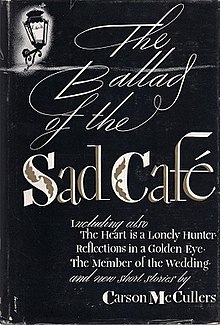 |
| die Verwandlung capa dunha das primeiras edicións 1916 |
Als Gregor Samsa
eines Morgens aus unruhigen Träumen erwachte, fand er sich in seinem Bett zu
einem ungeheueren Ungeziefer verwandelt. Er lag auf seinem panzerartig harten
Rücken und sah, wenn er den Kopf ein wenig hob, seinen gewölbten, braunen, von
bogenförmigen Versteifungen geteilten Bauch, auf dessen Höhe sich die
Bettdecke, zum gänzlichen Niedergleiten bereit, kaum noch erhalten konnte.
Seine vielen, im Vergleich zu seinem sonstigen Umfang kläglich dünnen Beine
flimmerten ihm hilflos vor den Augen.
»Was ist mit mir
geschehen?«, dachte er. Es war kein Traum. Sein Zimmer, ein richtiges, nur
etwas zu kleines Menschenzimmer, lag ruhig zwischen den vier wohlbekannten
Wänden. Über dem Tisch, auf dem eine auseinandergepackte Musterkollektion von
Tuchwaren ausgebreitet war - Samsa war Reisender - hing das Bild, das er vor
kurzem aus einer illustrierten Zeitschrift ausgeschnitten und in einem
hübschen, vergoldeten Rahmen untergebracht hatte. Es stellte eine Dame dar, die
mit einem Pelzhut und einer Pelzboa versehen, aufrecht dasaß und einen schweren
Pelzmuff, in dem ihr ganzer Unterarm verschwunden war, dem Beschauer
entgegenhob.
Gregors Blick
richtete sich dann zum Fenster, und das trübe Wetter - man hörte Regentropfen
auf das Fensterblech aufschlagen - machte ihn ganz melancholisch. »Wie wäre es,
wenn ich noch ein wenig weiterschliefe und alle Narrheiten vergäße«, dachte er,
aber das war gänzlich undurchführbar, denn er war gewöhnt, auf der rechten
Seite zu schlafen, konnte sich aber in seinem gegenwärtigen Zustand nicht in
diese Lage bringen. Mit welcher Kraft er sich auch auf die rechte Seite warf,
immer wieder schaukelte er in die Rückenlage zurück. Er versuchte es wohl
hundertmal, schloß die Augen, um die zappelnden Beine nicht sehen zu müssen,
und ließ erst ab, als er in der Seite einen noch nie gefühlten, leichten,
dumpfen Schmerz zu fühlen begann. »Ach Gott«, dachte er, »was für einen
anstrengenden Beruf habe ich gewählt! Tag aus, Tag ein auf der Reise. Die
geschäftlichen Aufregungen sind viel größer, als im eigentlichen Geschäft zu
Hause, und außerdem ist mir noch diese Plage des Reisens auferlegt, die Sorgen
um die Zuganschlüsse, das unregelmäßige, schlechte Essen, ein immer
wechselnder, nie andauernder, nie herzlich werdender menschlicher Verkehr. Der Teufel
soll das alles holen!« Er fühlte ein leichtes Jucken oben auf dem Bauch; schob
sich auf dem Rücken langsam näher zum Bettpfosten, um den Kopf besser heben zu
können; fand die juckende Stelle, die mit lauter kleinen weißen Pünktchen
besetzt war, die er nicht zu beurteilen verstand; und wollte mit einem Bein die
Stelle betasten, zog es aber gleich zurück, denn bei der Berührung umwehten ihn
Kälteschauer.
Er glitt wieder
in seine frühere Lage zurück. »Dies frühzeitige Aufstehen«, dachte er, »macht
einen ganz blödsinnig. Der Mensch muß seinen Schlaf haben. Andere Reisende
leben wie Haremsfrauen. Wenn ich zum Beispiel im Laufe des Vormittags ins
Gasthaus zurückgehe, um die erlangten Aufträge zu überschreiben, sitzen diese
Herren erst beim Frühstück. Das sollte ich bei meinem Chef versuchen; ich würde
auf der Stelle hinausfliegen. Wer weiß übrigens, ob das nicht sehr gut für mich
wäre. Wenn ich mich nicht wegen meiner Eltern zurückhielte, ich hätte längst
gekündigt, ich wäre vor den Chef hin getreten und hätte ihm meine Meinung von
Grund des Herzens aus gesagt. Vom Pult hätte er fallen müssen! Es ist auch eine
sonderbare Art, sich auf das Pult zu setzen und von der Höhe herab mit dem
Angestellten zu reden, der überdies wegen der Schwerhörigkeit des Chefs ganz nahe
herantreten muß. Nun, die Hoffnung ist noch nicht gänzlich aufgegeben; habe 2
ich einmal das Geld beisammen, um die Schuld der Eltern an ihn abzuzahlen - es
dürfte noch fünf bis sechs Jahre dauern -, mache ich die Sache unbedingt. Dann
wird der große Schnitt gemacht. Vorläufig allerdings muß ich aufstehen, denn
mein Zug fährt um fünf.«
 |
| representación de Kafka escribindo publicada en 'Faro de Vigo' 07 de xaneiro de 2016 |
Und er sah zur
Weckuhr hinüber, die auf dem Kasten tickte. »Himmlischer Vater!«, dachte er. Es
war halb sieben Uhr, und die Zeiger gingen ruhig vorwärts, es war sogar halb
vorüber, es näherte sich schon dreiviertel. Sollte der Wecker nicht geläutet
haben? Man sah vom Bett aus, daß er auf vier Uhr richtig eingestellt war; gewiß
hatte er auch geläutet. Ja, aber war es möglich, dieses möbelerschütternde
Läuten ruhig zu verschlafen? Nun, ruhig hatte er ja nicht geschlafen, aber
wahrscheinlich desto fester. Was aber sollte er jetzt tun? Der nächste Zug ging
um sieben Uhr; um den einzuholen, hätte er sich unsinnig beeilen müssen, und
die Kollektion war noch nicht eingepackt, und er selbst fühlte sich durchaus
nicht besonders frisch und beweglich. Und selbst wenn er den Zug einholte, ein
Donnerwetter des Chefs war nicht zu vermeiden, denn der Geschäftsdiener hatte
beim Fünfuhrzug gewartet und die Meldung von seiner Versäumnis längst
erstattet. Es war eine Kreatur des Chefs, ohne Rückgrat und Verstand. Wie nun,
wenn er sich krank meldete? Das wäre aber äußerst peinlich und verdächtig, denn
Gregor war während seines fünfjährigen Dienstes noch nicht einmal krank
gewesen. Gewiß würde der Chef mit dem Krankenkassenarzt kommen, würde den
Eltern wegen des faulen Sohnes Vorwürfe machen und alle Einwände durch den
Hinweis auf den Krankenkassenarzt abschneiden, für den es ja überhaupt nur ganz
gesunde, aber arbeitsscheue Menschen gibt. Und hätte er übrigens in diesem
Falle so ganz unrecht? Gregor fühlte sich tatsächlich, abgesehen von einer nach
dem langen Schlaf wirklich überflüssigen Schläfrigkeit, ganz wohl und hatte
sogar einen besonders kräftigen Hunger.
die
Verwandlung
Franz
Kafka
unha
obra completada en 1912
traducido
ao galego por Xosé María García Álvarez e publicado como
A
metamorfose
Compostela,
Sotelo Blanco, 1990
Unha
mañá, ó espertar dun soño desacougante, Gregor Samsa achouse no seu leito
transformado nun insecto monstruoso. Estaba deitado sobre a dura coiraza do seu
lombo e, ó erguer un pouco a cabeza, percibiu a forma convexa e pardusca do seu
ventre dividido por longas e arqueadas costras, tan altas que o cobertor da
cama, que xa estaba a piques de esvarar ó chan, case nin se podía soster sobre
Blas. As súas numerosas patas, magoantemente fracas comparadas co grosor normal
das pernas de Gregor, buligaban desesperadamente perante os seus ollos.
«¿Que
me aconteceu?», pensou. Non, non era ningún soño. A súa habitación, aínda que
un pouco pequena, era un verdadeiro dormitorio humano e alí estaba, en calma,
no medio das lúas catro paredes, que para el eran ben familiares. Enriba da
mesa, sobre a que estaba estendido o contido dun mostrario de panos -Samsa era
viaxante- pendía a imaxe que había pouco el recortara dunha revista e encadrara
nun bonito marco dourado. Representaba unha dona cun chapeu de pel e un boá
tamén de pel; estaba sentada co busto dereito e sostendo fronte ó espectador un
enorme manguito de pel no interior do cal desaparecía todo o seu antebrazo.
 |
| a metamorfose capa da edición galega 1990 |
Despois,
Gregor dirixiu a ollada á fiestra; o tempo grisallo -sentíanse cae-las pingas
de choiva sobre o beiril de lata da fiestra- meteulle no corpo unha grande
melancolía. «¿Como sería se durmise un pouco máis e esquecese todas aquelas
tolerías?», pensou. Pero ¡so era unha cousa completamente irrealizable, porque
estaba afeito a durmir sobre o costado dereito, pero no seu estado presente non
era quen de acadar esa postura. Por máis forza que empregaba en tombarse sobre
o seu lado dereito, sempre volvía, abaneándose, a quedar deitado sobre o lombo.
Tentouno polo menos cen veces; pechou os ollos para non ter que ve-lo buligar
das súas patas e só renunciou a seguir esforzándose cando comezou a sentir nun
costado unha dor lixeira, xorda, que aínda nunca experimentara. «¡Vállame
Deus!», pensou. «¡Que profesión tan esgotadora escollín! Nin un só día sen saír
de viaxe. Os sobresaltos profesionais son moito máis grandes ca na propia sede
central da empresa e, aínda por riba, impúxoseme esa praga de ter que andar de
viaxe, as preocupacións polos enlaces dos trens, a comida fóra de hora e de
mala calidade, unhas relacións humanas sempre cambiantes e curtas que nunca
chegan a ser cordiais. ¡Que o demo o leve todo!» Sentiu unha lixeira comechón
alá no alto da barriga. Vagarosamente, arrastrándose sobre as costas, foise
achegando ata un dos paus da cama para poder erguer mellor a cabeza. Atopou o
sitio onde lle picaba: estaba todo cuberto de puntiños brancos, que el non
conseguiu explicar. Quixo apalpa-lo sitio cunha pata, pero retirouna no mesmo
instante, porque só con tocalo ondas de calafrío lle percorrían o corpo.
Esvarou
ata a posición anterior. «Estes madrugóns», pensou, «apárvano a un totalmente.
O ser humano precisa do sono. Outros viaxantes levan unha vida de odaliscas.
Por poñer un caso, cando a media mañá volvo á fonda para anota-los pedidos,
eses señores aínda están sentados, a almorzaren. Se eu me atrevese a face-lo
mesmo co xefe que teño, botaríame fóra no intre. Por certo, ¿quen sabe se isto
ó mellor non é o que máis me convén? Se non me contivese, por mor de meus pais,
xa tiña pedida a baixa hai tempo; presentaríame diante do xefe e coa maior
franqueza diríalle o que penso. ¡Seguro que había caer do seu pupitre! Por
certo, que tamén é unha teima ben rara esa de sentar no pupitre e dende aquela
altura falarlle ó empregado, que, como o xefe é duro de oído, tense que achegar
mesmo a carón del. De calquera xeito, aínda non perdín toda a esperanza. En
canto teña xuntos os cartos para lle paga-la débeda de meus pais -aínda haberá
que agardar uns cinco ou seis anos-, vouno facer sen falta. E daquela
producirase a grande ruptura. Pero polo de agora téñome que erguer, porque o
meu tren sae ás cinco».
E
ergueu a vista cara ó espertador que seguía a face-lo seu tiquetaque sobre a
mesa de noite. «¡Deus divino!», dixo para os seus adentros. Eran as seis e
media, as agullas do reloxo seguían a avanzar tranquilamente, e mesmo xa pasaba
da media. E xa se achegaban ós tres cuartos. ¿Podería ser que, o espertador non
soase? Dende a cama víase ben que estaba correctamente posto para as catro da
mañá; certo que tivera que soar. ¿Pero sería posible seguir durmindo, coma se
nada, con aquel repenique que facía treme-los mobles? De feito, o que se di con
tranquilidade tampouco durmira, pero precisamente por iso tivera un sono máis
profundo. Pero, ¿que debería facer agora? O próximo tren tiña a saída ás sete;
para apañalo tería que bulir coma un tolo, pero o mostrario aínda estaba sen
empaquetar e el mesmo aínda non se sentía o que se di alá moi esperto e áxil.
E, mesmo se chegase a colle-lo tren, non podería esquivar unha pauliña do xefe,
porque o mozo do almacén estaría a esperar polo tren das cinco e xa iría un
anaco dende que dera parte da súa ausencia. Aquel rapaz era un monicreque do
xefe, servil e carente de entendemento. Mais, ¿que pasaría se mandase aviso de
que estaba enfermo? De calquera xeito, iso sería extraordinariamente magoante
para el e sospeitoso polo feito de que Gregor, nos seus cinco anos de servicio,
aínda non estivera enfermo nin unha soa vez. O máis probable era que viñese o
xefe acompañado polo médico do seguro: faríalles reproches a seus pais por
causa do lacazán de seu fillo e rexeitaría de raíz tódalas obxeccións coa
referencia do médico do seguro, para o cal só existen homes completamente sans,
pero preguiceiros. E, a propósito, ¿neste caso faltaríalle toda a razón? De
feito, á parte da sensación de somnolencia certamente inexplicable despois da
súa Tonga durmida, Gregor atopábase perfectamente ben e, o que aínda é máis,
estaba especialmente famento.









